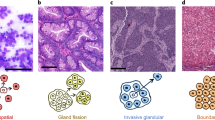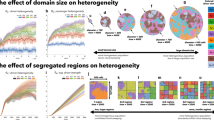Abstract
Classical models of tumorigenesis assume that the mutations which cause tumours to grow act in a cell-autonomous fashion. This is not necessarily true. Sometimes tumour cells may adopt genetic strategies that boost their own replication and which also influence other cells in the tumour, whether directly or as a side-effect. Tumour growth as a whole might be enhanced or retarded. We have used mathematical models to study two non-autonomous strategies that tumour cells may use. First, we have considered the production by tumour cells of an angiogenesis growth factor that benefits both the cell from which it originates and neighbouring cells. Second, we have analysed a situation in which tumour cells produce autocrine-only or paracrine-only growth factors to prevent programmed cell death. In the angiogenesis model, stable genetic polymorphisms are likely to occur between cells producing and not producing the growth factor. In the programmed cell death model, cells with autocrine growth factor production can spread throughout the tumour. Production of paracrine-only growth factor is never selected because it is 'altruistic' (that is of no benefit to the cell that makes the growth factor), despite being potentially beneficial to tumour growth as a whole. No polymorphisms can occur in the programmed cell death model. Production of angiogenesis and other growth factors in tumours may be under stable genetic, rather than epigenetic, control, with implications for therapies aimed at such targets. Many of the mutations observed in tumours may have non-autonomous effects.
This is a preview of subscription content, access via your institution
Access options
Subscribe to this journal
Receive 24 print issues and online access
$259.00 per year
only $10.79 per issue
Buy this article
- Purchase on Springer Link
- Instant access to full article PDF
Prices may be subject to local taxes which are calculated during checkout
Similar content being viewed by others
Author information
Authors and Affiliations
Rights and permissions
About this article
Cite this article
Tomlinson, I., Bodmer, W. Modelling the consequences of interactions between tumour cells. Br J Cancer 75, 157–160 (1997). https://doi.org/10.1038/bjc.1997.26
Issue Date:
DOI: https://doi.org/10.1038/bjc.1997.26
This article is cited by
-
Cooperation among cancer cells: applying game theory to cancer
Nature Reviews Cancer (2019)
-
Neighborhood size-effects shape growing population dynamics in evolutionary public goods games
Communications Biology (2019)
-
Fibroblasts and alectinib switch the evolutionary games played by non-small cell lung cancer
Nature Ecology & Evolution (2019)
-
Cancer treatment scheduling and dynamic heterogeneity in social dilemmas of tumour acidity and vasculature
British Journal of Cancer (2017)
-
Cancer heterogeneity and multilayer spatial evolutionary games
Biology Direct (2016)



